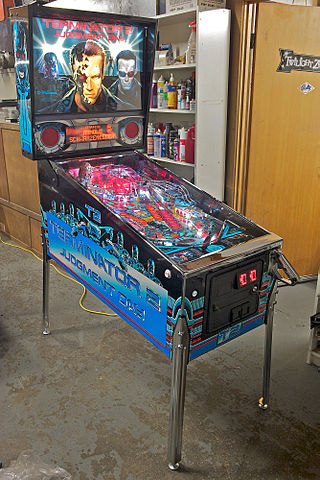
Pinball games are a family of games in which a ball is propelled into a specially designed table where it bounces off various obstacles, scoring points either en route or when it comes to rest. Historically the board was studded with nails called 'pins' and had hollows or pockets which scored points if the ball came to rest in them. Today, pinball is most commonly an arcade game in which the ball is fired into a specially designed cabinet known as a pinball machine, hitting various lights, bumpers, ramps, and other targets depending on its design. The game's object is generally to score as many points as possible by hitting these targets and making various shots with flippers before the ball is lost. Most pinball machines use one ball per turn, and the game ends when the ball(s) from the last turn are lost. The biggest pinball machine manufacturers historically include Bally Manufacturing, Gottlieb, Williams Electronics and Stern Pinball.

Pinball is a pinball video game developed by Nintendo and HAL Laboratory and published by Nintendo for the Nintendo Entertainment System. It is based on a Game & Watch unit of the same name, and was first released for the Famicom in Japan in 1984. It was later released as an arcade game for the Nintendo VS. System in Japan and North America in 1984. In 1985, it was a launch game for the Nintendo Entertainment System in North America.
A glossary of terms, commonly used in discussing pinball machines.

Medieval Madness is a Williams pinball machine released in June 1997. Designed by Brian Eddy and programmed by Lyman Sheats, it had a production run of 4,016 units. As of April 3, 2022, the Pinside pinball community lists it as the #2 highest-ranked pinball machine ; many adherents consider it the greatest of all time.
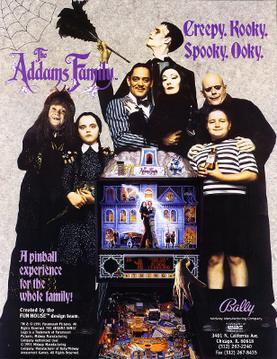
The Addams Family is a pinball machine released in March 1992. It was designed by Pat Lawlor and Larry DeMar and released by Midway. It was based on the 1991 film of the same name, and features custom speech by the stars of the film, Anjelica Huston and Raul Julia. It is the best-selling solid state pinball machine of all time with 20,270 units sold.

Star Trek: The Next Generation is a widebody pinball game, designed by Steve Ritchie and released in November 1993 by Williams Electronics. It was part of WMS' SuperPin series, and was based on the TV series. It is the only pinball machine that features three separate highscore-lists. Apart from the regular highscore-list and the buy-in-list, it also features a reminiscence to The Machine: Bride of Pin*Bot billionaires club. It is also the third pinball game overall based on the Star Trek franchise, following the 1979 pinball game by Bally, and the 1991 game by Data East, and preceding the 2013 pinball game by Stern.
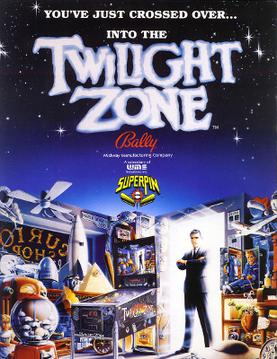
Twilight Zone is a widebody pinball machine, designed by Pat Lawlor and based on the TV series of the same name. It was first released in 1993 by Midway. This game is part of WMS' SuperPin line of widebody games alongside Star Trek: The Next Generation and Indiana Jones: The Pinball Adventure.

Cirqus Voltaire is a 1997 pinball game, designed by John Popadiuk and released by Williams Electronics Games. The theme involves the player performing many different marvels in order to join the circus. Some of the game's distinctive features include a neon light running along the right-hand ramp, a pop bumper that rises up from the middle of the playfield at certain times, and a magnet at the top of the left ramp that can catch balls and divert them into the locks. The most notable feature is the Ringmaster, a head that rises at certain times and taunts the player.

Fish Tales is a fishing-themed pinball game released by Williams in 1992. It is one of the top 20 most produced pinball machines of all time, selling more than 13,000 units.

The Flintstones is a pinball game released by Williams in 1994 and based on the movie of the same name which is based on 1960–1966 animated television series of the same name. This machine is not to be confused with another pinball machine, a redemption game, based on the TV series and also released in 1994, manufactured by Innovative Concepts in Entertainment (ICE).

Creature from the Black Lagoon is a pinball machine designed by John Trudeau and released by Midway. It is loosely based on the movie of the same name. The game's theme is 1950s drive-in theater. The pinball game was licensed from Universal Studios by Bally so that all backglass and cabinet artwork and creature depictions would resemble those of the original movie.
There have been four pinball adaptations of the film Jurassic Park franchise: a physical table released by Data East the same year the film came out, Sega's 1997 The Lost World which is based on the second movie of the series, a virtual table developed by Zen Studios on the franchise's 25th anniversary and a new physical table released by Stern Pinball a year after. All four tables behave differently.
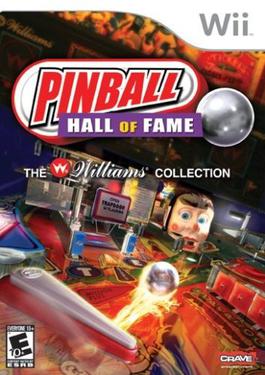
Pinball Hall of Fame: The Williams Collection is a pinball video game developed by FarSight Studios and published by Crave Entertainment for Wii, PlayStation 2, PlayStation 3, PlayStation Portable, Xbox 360, and Nintendo 3DS. Players play on a variety of classic virtual pinball machines from Williams Electronics' history. The Williams Collection follows the previous title, Pinball Hall of Fame: The Gottlieb Collection.
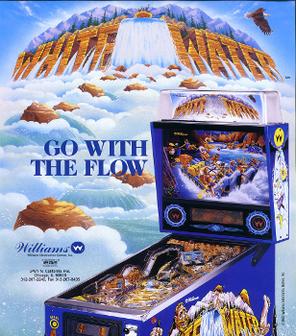
White Water is a 1993 pinball game designed by Dennis Nordman and released by Williams. The theme is based on white water rafting, which is reflected in the game's 'wild' ramps and very fast game-play.

Jack-Bot is a 1995 pinball game which was designed by Barry Oursler and Larry DeMar, and released by Williams. It is the third game in the Pin-Bot series, following Pin-Bot (1986) and The Machine: Bride of Pin-Bot (1991).

Who Dunnit is a Midway pinball machine with a 1940s style and a murder mystery theme. The playfield features up to five different murder mysteries by revealing clues by sending the ball to an elevator, phone, or slot machine. The machine accepts up to four players, and features four-ball play.
Police Force is a 1989 Williams pinball machine. The pinball machine was initially supposed to be released as Batman pinball, the police car was to be the Batmobile and the Jail was to be the Bat Cave. The machine features anthropomorphic jungle animals in the roles of police and robbers.

Genie is a widebody pinball machine designed by Ed Krynski and released in 1979 by Gottlieb. It features a jinn theme and was advertised with the slogans "Gottlieb's WIDE and Beautiful BODY" and "A Wide-Body Pinball absolutely bulging with player appeal and proven massive profit earning capacity!".
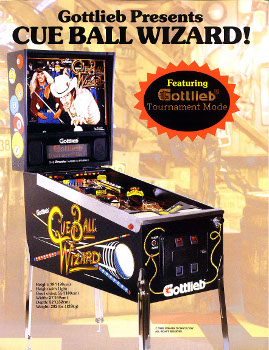
Cue Ball Wizard is a pinball machine designed by Jon Norris and released in December 18 1992 by Gottlieb. It features a cue sports theme and was advertised with the slogan "Gottlieb Presents CUE BALL WIZARD!".

Eight Ball Deluxe is a pinball machine designed by George Christian and released by Bally in 1981. The game features a cue sports theme and was so popular that it was produced again in 1984.
















